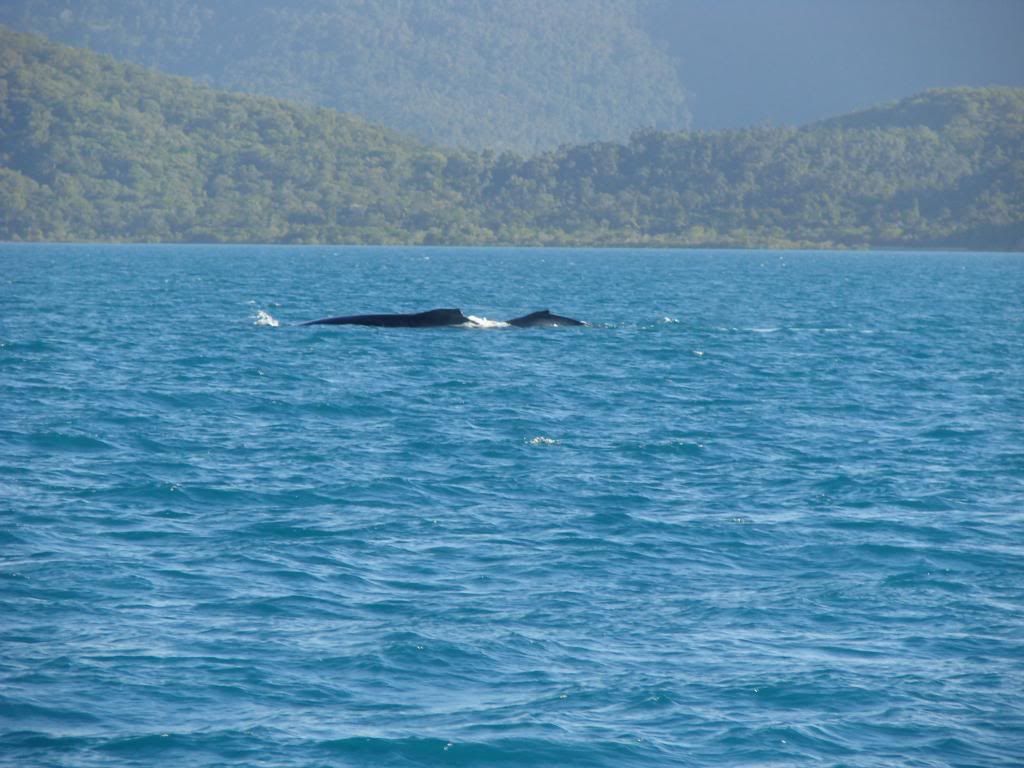 We continued up the coast with a stopover on Magnetic Island, which had lots of wildlife and a series of WWII forts as the island was the first line of defense against the Japanese. Our final bus stop on the east coast was Cairns. Although we had planned to do more snorkelling/diving on the Reef, after spending way too much the day before on our monopolized flight to Darwin (and the Kakadu/Litchfield tours), we decided to go to the free botanical gardens and also hung out with the last remnants of the Fraser crew.
We continued up the coast with a stopover on Magnetic Island, which had lots of wildlife and a series of WWII forts as the island was the first line of defense against the Japanese. Our final bus stop on the east coast was Cairns. Although we had planned to do more snorkelling/diving on the Reef, after spending way too much the day before on our monopolized flight to Darwin (and the Kakadu/Litchfield tours), we decided to go to the free botanical gardens and also hung out with the last remnants of the Fraser crew.Although we were supposed to go to Kakadu first, our itineraries got switched around because many of their guides were out with the flu. Thus, we spent our first day exploring Litchfield NP. Exploring isn’t really the right word considering we were just bussed from one exhibit to the next. The first was a series of termite mounds made by a variety of species of termites.
 The most picturesque of the bunch were the Cathedral termites (see if you can spot Ganesh in the pic). Incredibly, the mounds are both water- and fire-proof! We also saw a bunch of Wooly Butt trees, a type of eucalyptus that are noteworthy because their bark only extends about half-way down and then vanishes. The bulk of the day was spent going to four different waterfalls, three of which we were allowed to swim. The final water locale was the most fun as there were a series of pools, some of which we could jump into off the rocks. Jason had a pretty nasty fall on the slippery rocks and for a few minutes we feared he might have broken his elbow. Thankfully our fears were not realized.
The most picturesque of the bunch were the Cathedral termites (see if you can spot Ganesh in the pic). Incredibly, the mounds are both water- and fire-proof! We also saw a bunch of Wooly Butt trees, a type of eucalyptus that are noteworthy because their bark only extends about half-way down and then vanishes. The bulk of the day was spent going to four different waterfalls, three of which we were allowed to swim. The final water locale was the most fun as there were a series of pools, some of which we could jump into off the rocks. Jason had a pretty nasty fall on the slippery rocks and for a few minutes we feared he might have broken his elbow. Thankfully our fears were not realized. 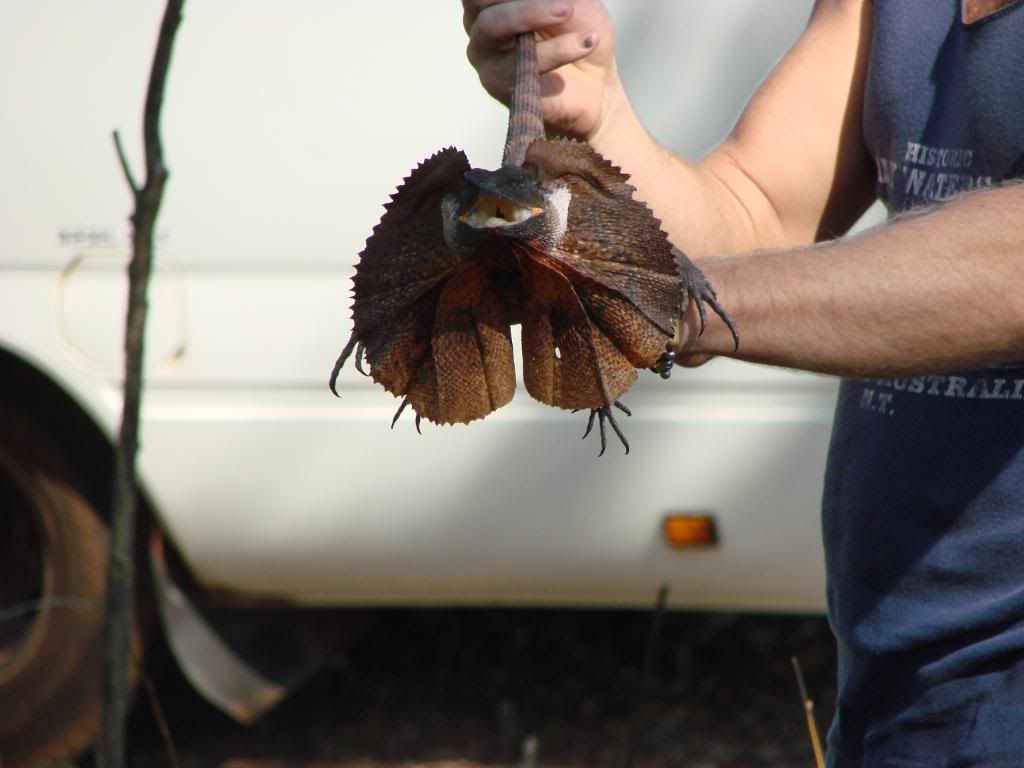 On the way back, our tour guide suddenly stopped the van, ran into the bush, and caught a famous type of lizard (can’t recall the name) and induced it to flare out the sides of its neck. Our final stop of the day was to see some long-necked turtles and feed some huge Barramundis, who are hermaphroditic and transform from males to females at a certain age. Due to this unique characteristic, they are legally not allowed to be caught until they have turned into females (to ensure they’ve had a chance to lay eggs).
On the way back, our tour guide suddenly stopped the van, ran into the bush, and caught a famous type of lizard (can’t recall the name) and induced it to flare out the sides of its neck. Our final stop of the day was to see some long-necked turtles and feed some huge Barramundis, who are hermaphroditic and transform from males to females at a certain age. Due to this unique characteristic, they are legally not allowed to be caught until they have turned into females (to ensure they’ve had a chance to lay eggs).Early the next morning we left for Kakadu NP. The trip got off to a bit of a rocky start as one of the passengers, an Aussie named Kat, was about 20 minutes late because she’d been out partying the night before.
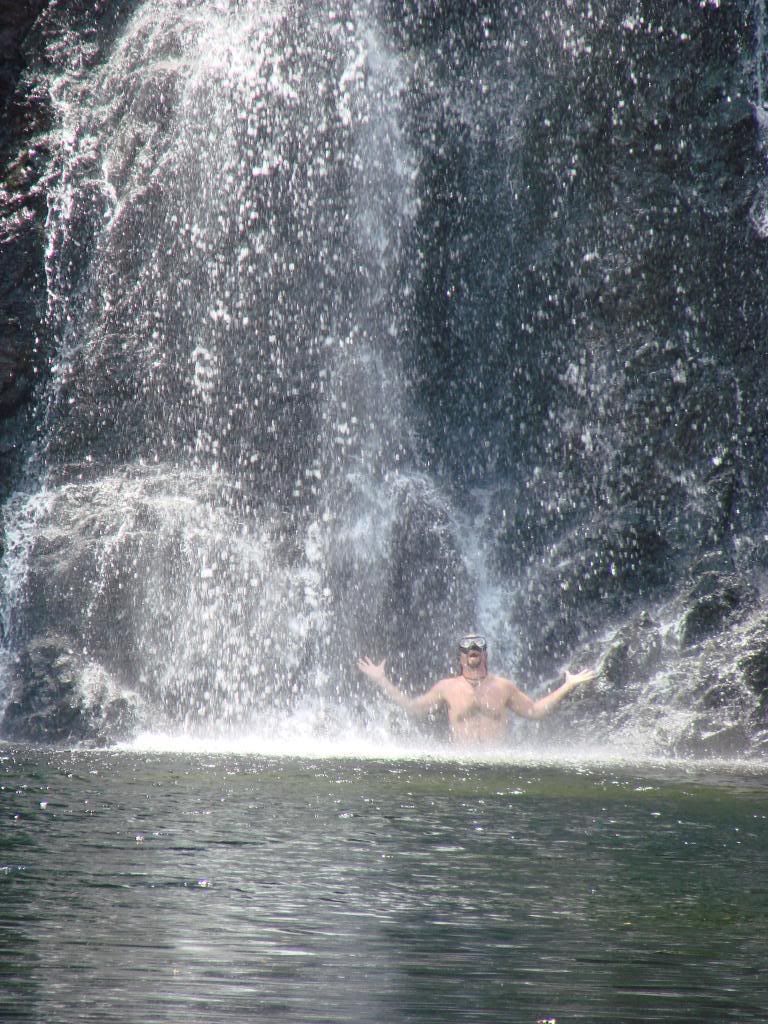 By the end of the trip, she had developed quite the complex over her tardiness, and Priti made sure to get her contact information for future reference. The rest of us: Paul, a vegetarian Aussie male (a rarity) from the violent town of Woolongong, who’d witnessed a shooting the night before; Charlie, an 18-year-old Brit who’d seen more of the world than most people twice his age; Frank and Micheal (or Hakeem since he wore an Olajuwon jersey the whole trip), Germans in Australia for a family wedding;
By the end of the trip, she had developed quite the complex over her tardiness, and Priti made sure to get her contact information for future reference. The rest of us: Paul, a vegetarian Aussie male (a rarity) from the violent town of Woolongong, who’d witnessed a shooting the night before; Charlie, an 18-year-old Brit who’d seen more of the world than most people twice his age; Frank and Micheal (or Hakeem since he wore an Olajuwon jersey the whole trip), Germans in Australia for a family wedding;  Felix, a German medical student doing a rotation in Darwin, and his friend Andreas; and the inimitable Cam, our Aussie tour guide and a true survivalist. Interestingly, from what we saw, the Germans in Darwin outnumbered every other group. Overall, it was a great group and everyone was more than willing to pull their own weight. Whereas most of the group, upon introducing themselves, said they wanted to have fun and see wildlife, Jason said “no offense folks, but I want to see a croc mauling.” Cam rightfully declared it should be Kat given our delay on her behalf. (Hey, Priti needs some clientele!)
Felix, a German medical student doing a rotation in Darwin, and his friend Andreas; and the inimitable Cam, our Aussie tour guide and a true survivalist. Interestingly, from what we saw, the Germans in Darwin outnumbered every other group. Overall, it was a great group and everyone was more than willing to pull their own weight. Whereas most of the group, upon introducing themselves, said they wanted to have fun and see wildlife, Jason said “no offense folks, but I want to see a croc mauling.” Cam rightfully declared it should be Kat given our delay on her behalf. (Hey, Priti needs some clientele!)The tour started with a crocodile cruise but our first of many wildlife experiences was a tragic one, as a wallaby came running along side of our vehicle, then unsuccessfully tried to jump through the gap between the truck and the trailer. It was Cam’s first killing of the year and the rest of us were not quite sure whether he was joking when he said we’d be having it for dinner. While sitting in the front seat, Jason discovered a few interesting parallels with Cam, since they had the same brand of sandals (Chaco) and MP3 players (Toshiba).
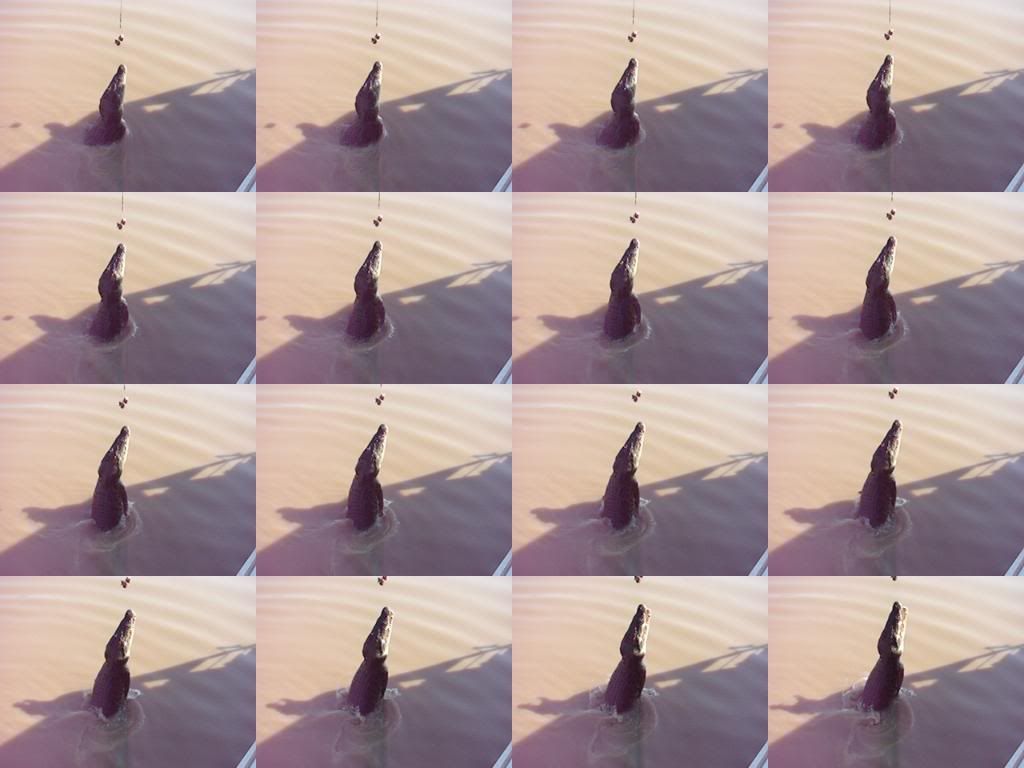 The latter brought back fond but bitter memories for Jason, as his had been dead since running out of juice on Fraser Island (due to a manufacturing glitch, the normal route of recharging via the laptop does not work if the battery is completely dead). During the croc cruise, we saw about a dozen “salties” (a good example of the Aussie lexicon of taking the first syllable and adding “ies” to it, “sunnies” being another personal favorite since Jason had to buy another pair after breaking his on the Whitsundays trip). They would dangle raw meat over the water to get them to “jump”. One of the crocs was over 100 years old and he was a massive beast. They had to be careful not to dangle the meat when multiple crocs were in the vicinity as they are cannibals and might end up killing each other, like they do in Woolongong.
The latter brought back fond but bitter memories for Jason, as his had been dead since running out of juice on Fraser Island (due to a manufacturing glitch, the normal route of recharging via the laptop does not work if the battery is completely dead). During the croc cruise, we saw about a dozen “salties” (a good example of the Aussie lexicon of taking the first syllable and adding “ies” to it, “sunnies” being another personal favorite since Jason had to buy another pair after breaking his on the Whitsundays trip). They would dangle raw meat over the water to get them to “jump”. One of the crocs was over 100 years old and he was a massive beast. They had to be careful not to dangle the meat when multiple crocs were in the vicinity as they are cannibals and might end up killing each other, like they do in Woolongong. 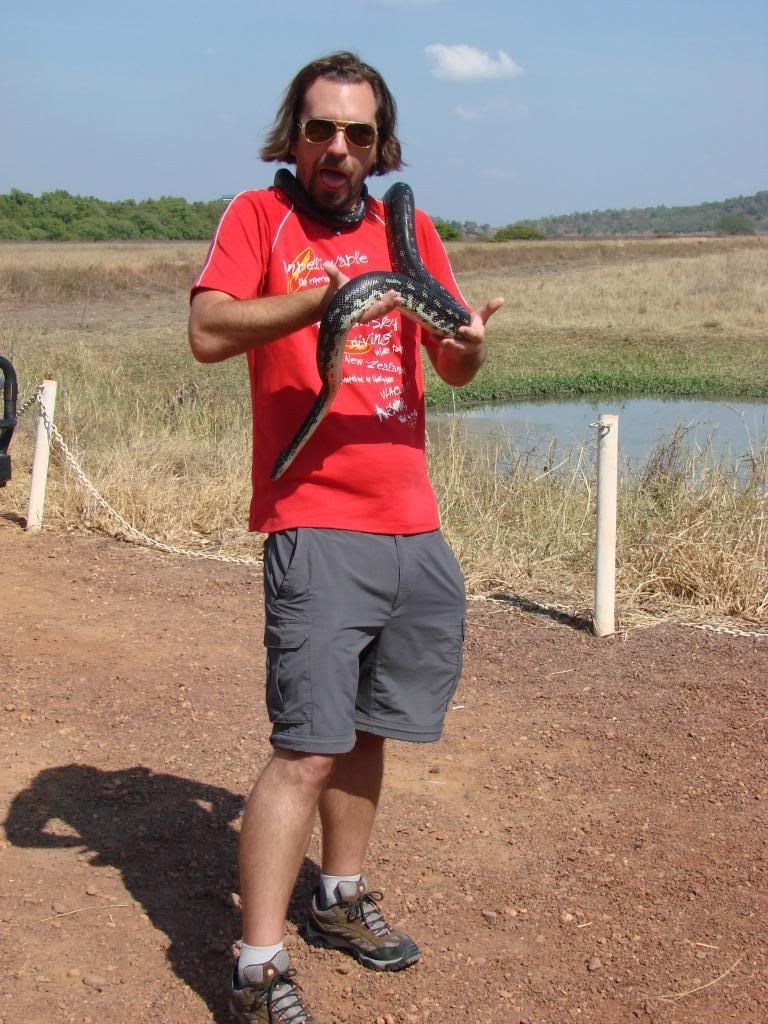 We also got to hold this non-poisonous (a rarity) diamond python, which promptly wrapped itself around Jason’s neck (right after Priti held it, coincidence?). After the croc cruise, we had a pretty long drive, as Kakadu is gargantuan, a total area larger than Switzerland. After stopping for lunch, we set up camp at Maguk, and then hiked to this spot that had lots of pools, most of which were at least 10 meters deep. While the rest of the group kept going to more pools, we hung back and Jason, ever such the rebel and in defiance of Cam’s explicit instructions, jumped off the rocks into the pools.
We also got to hold this non-poisonous (a rarity) diamond python, which promptly wrapped itself around Jason’s neck (right after Priti held it, coincidence?). After the croc cruise, we had a pretty long drive, as Kakadu is gargantuan, a total area larger than Switzerland. After stopping for lunch, we set up camp at Maguk, and then hiked to this spot that had lots of pools, most of which were at least 10 meters deep. While the rest of the group kept going to more pools, we hung back and Jason, ever such the rebel and in defiance of Cam’s explicit instructions, jumped off the rocks into the pools.  Jason had again brought his mask so we took turns trying to skindive to the bottom of the various pools, all at least 10 meters deep; only Charlie made it. One of the pools was almost like a cave, as we accessed it by swimming down a couple meters underneath one of the rocks.
Jason had again brought his mask so we took turns trying to skindive to the bottom of the various pools, all at least 10 meters deep; only Charlie made it. One of the pools was almost like a cave, as we accessed it by swimming down a couple meters underneath one of the rocks.That night, all of us learned firsthand that Cam had previously been employed as a chef. He cooked us some buffalo sausages and we both got to try some kangaroo for the first time. It’s apparently one of the healthiest red meats and it tasted somewhat like beef but lighter. Cam shared some of his memorable experiences as a tour guide and also told us how Kakadu was completely different during the wet season (Nov-Mar), as much of the park becomes completely submerged due to interminable rains, thereby giving crocodiles much greater range throughout the park. After dinner, we had a good time discussing, among other things, the Futbol history between Germany and Italy (who defeated Germany yet again in the 2006 World Cup semis, viva Italia!), and the best scenes from The Simpsons movie (the swap between the faithful and the bar patrons), while Andreas kept count of everyone’s beer consumption. We managed not to drink all of it the first night as we were in for an early morning and long day.
Groggily, we awoke at the crack of dawn to break camp and hit the most famous spots in Kakadu. First was Twin Falls, which, due to a German tourist being eaten by a croc a few years ago, was off limits to swimmers and thus only accessible by a five-minute boat ride (that cost $12.50).
 As nice as the Twin Falls were, it was pretty disappointing that we weren’t able to swim, particularly since we’d just hiked for an hour in 40 (104 C) degrees coupled with extreme humidity. At some point during the day, we crossed the yellow river, where the water was so deep that the engine (that had a snorkel) was submerged and the water began seeping in through the back of the van. After another hour or so on a road that reminded us both of Fraser (i.e., BUMPY), we arrived at Jim Jim Falls. Like many of the names in Kakadu, it was a malapropism due to the White Man’s inability or unwillingness to understand the Aboriginal language (I suppose with names like Kunbarllanjnja and Malabanjbanjdju, it’s somewhat understandable). Unfortunately, Jim Jim Falls were anything but, as only a trickle was left after nearly a full dry season. Nonetheless, the 300 meter cliff face was a marvel to behold and at least we got to swim. The waters directly beneath the “Falls” were freezing so we opted to hang out in the warmer pools (but not the luke warm one, which Cam revealed a bit too much of himself when he exclaimed “it’s like swimming in piss”).
As nice as the Twin Falls were, it was pretty disappointing that we weren’t able to swim, particularly since we’d just hiked for an hour in 40 (104 C) degrees coupled with extreme humidity. At some point during the day, we crossed the yellow river, where the water was so deep that the engine (that had a snorkel) was submerged and the water began seeping in through the back of the van. After another hour or so on a road that reminded us both of Fraser (i.e., BUMPY), we arrived at Jim Jim Falls. Like many of the names in Kakadu, it was a malapropism due to the White Man’s inability or unwillingness to understand the Aboriginal language (I suppose with names like Kunbarllanjnja and Malabanjbanjdju, it’s somewhat understandable). Unfortunately, Jim Jim Falls were anything but, as only a trickle was left after nearly a full dry season. Nonetheless, the 300 meter cliff face was a marvel to behold and at least we got to swim. The waters directly beneath the “Falls” were freezing so we opted to hang out in the warmer pools (but not the luke warm one, which Cam revealed a bit too much of himself when he exclaimed “it’s like swimming in piss”). 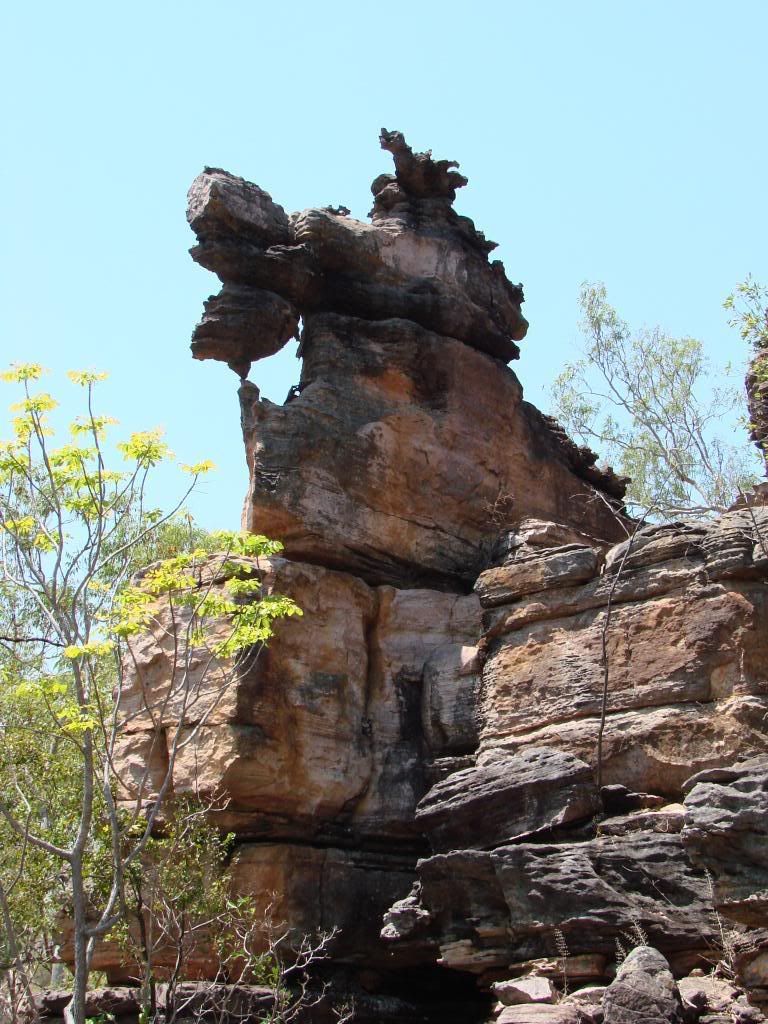 After playing Classic Catch for awhile, by diving into the water off this tiny sand island, Cam orchestrated a game akin to dodgeball, where those in the water took turns flinging a small football at those in the sand. Sadly for Cam, or more appropriately his offspring, the game ended with him taking a ball from Jason directly in the groin. Jason couldn’t stop laughing and fortunately Cam wasn’t seriously injured and was a good sport.
After playing Classic Catch for awhile, by diving into the water off this tiny sand island, Cam orchestrated a game akin to dodgeball, where those in the water took turns flinging a small football at those in the sand. Sadly for Cam, or more appropriately his offspring, the game ended with him taking a ball from Jason directly in the groin. Jason couldn’t stop laughing and fortunately Cam wasn’t seriously injured and was a good sport.That evening, after another scrumptious meal of lamb chops, teriyaki vegetables, and baked potatoes, Cam brought out his didgeridoo and gave us all a brief lesson in playing. We all gave decent efforts, but, sans circular breathing, which takes months to learn, the playing comes in spurts. After bringing over a few women from the neighboring camp, Cam proceeded to lead us on a nighttime nature hike. With about a dozen in tow, there was virtually no chance of spotting anything noteworthy, so we ended up laying down in a field and gazing at the stars while engaging in some random conversations, such as the future of humanity and the nature of the space/time continuum. What’s cool about stargazing in Australia is that the stars are completely different and so is the Milky Way itself, which is much splotchier in appearance relative to the mostly uniform band of haze we see in the northern hemisphere.
Another early morning for the crew on our final day in Kakadu brought us to a series of rock art paintings. Incredibly, carbon dating has revealed that one of the Aboriginal tribes had been creating paintings for 57,000 years, making them the oldest civilization on earth.
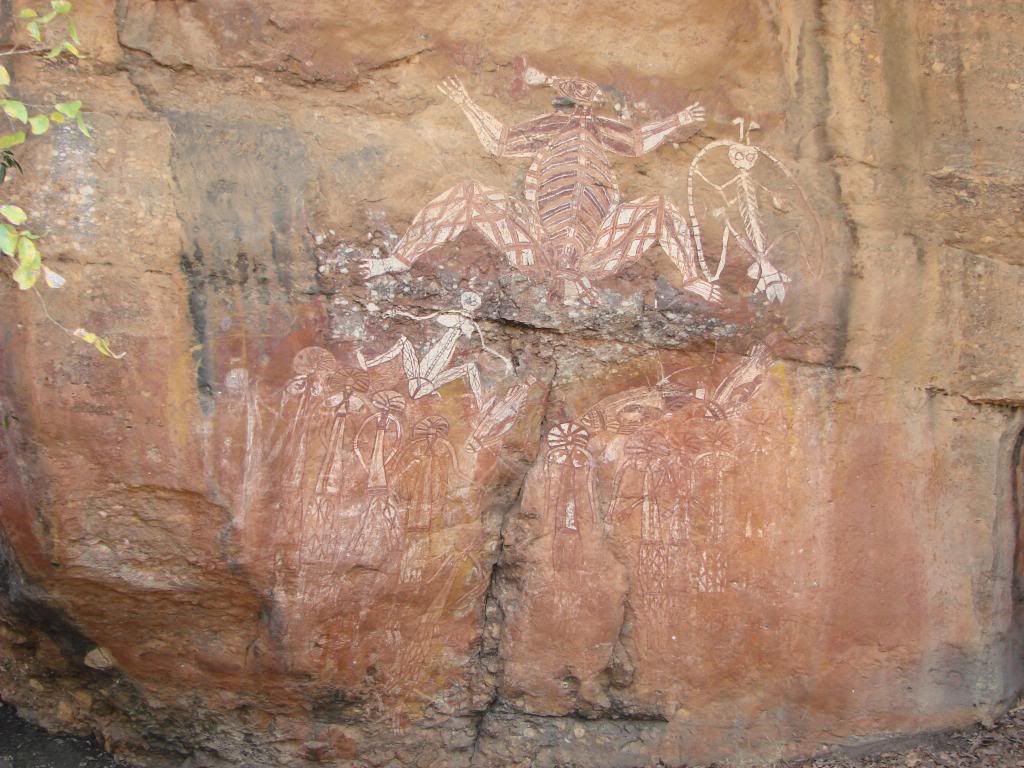 Tragically, their tribe died out in 1969, as the youngest members left the tribe to pursue a western lifestyle. Cam expertly relayed many stories behind the paintings, including the formation of crocodiles, the Aboriginal version of the boogeyman, and the spirits that were believed to have painted themselves. Doubt them at your own risk. Throughout the final day, everyone had their expectations met as we saw tons of wildlife. In the morning we saw a couple of salties in the wild, although our prompting for them to fight went unheeded.
Tragically, their tribe died out in 1969, as the youngest members left the tribe to pursue a western lifestyle. Cam expertly relayed many stories behind the paintings, including the formation of crocodiles, the Aboriginal version of the boogeyman, and the spirits that were believed to have painted themselves. Doubt them at your own risk. Throughout the final day, everyone had their expectations met as we saw tons of wildlife. In the morning we saw a couple of salties in the wild, although our prompting for them to fight went unheeded. 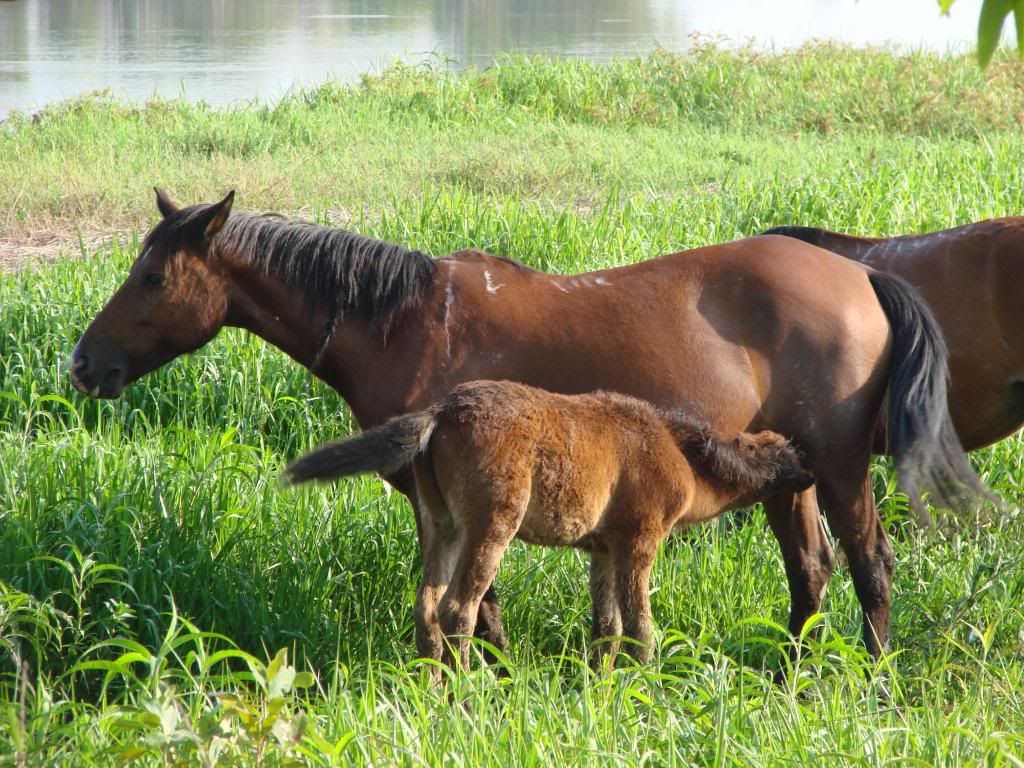 Next we saw a pack of wild horses (cue Mick) consisting of one stallion, four(!) mares, and two youngsters. At one of the rock art sites, we saw some wallaroos, which are similar to wallabies. Other wildlife we spotted included buffaloes, cockatoos, egrits, flying black kites, and a white-chested sea eagle. The ultimate wildlife experience occurred on our way out of the park, as Cam antagonized a freshie with his didgeridoo into charging our 4x4.
Next we saw a pack of wild horses (cue Mick) consisting of one stallion, four(!) mares, and two youngsters. At one of the rock art sites, we saw some wallaroos, which are similar to wallabies. Other wildlife we spotted included buffaloes, cockatoos, egrits, flying black kites, and a white-chested sea eagle. The ultimate wildlife experience occurred on our way out of the park, as Cam antagonized a freshie with his didgeridoo into charging our 4x4. 
 Jason got out and took pictures and managed not to get mauled in the process (imagine the irony). As we drove back into Darwin, the sun was visible through the trees, a fiery red ball that reminded us of a famous Magritte painting in the Chicago Art Institute.
Jason got out and took pictures and managed not to get mauled in the process (imagine the irony). As we drove back into Darwin, the sun was visible through the trees, a fiery red ball that reminded us of a famous Magritte painting in the Chicago Art Institute.Our final day in Australia was pretty uneventful, although we had a few instances of good luck, as a used book store owner paid us cash for our guidebook and the hostel receptionist gave us free shuttle passes after being entertained by the fact that we had saved exactly enough cash (or so we thought) for the tickets. And, Jason finally found an electronics store that could recharge his Gigabeat. Although we had enjoyed our trip thus far, we both realized that the true adventure was about to begin.
Reflecting on our time in Australia, there are a few things that stand out for those of you who are planning to go there. First, it’s BIG (like the mighty Banyan tree).
 We were there for a month and only traveled up the east coast and Darwin, and we felt rushed almost the entire time. It’s deceptively large because it’s an island and there’s nothing but a big rock in the middle, but make no mistake. It didn’t help that we traversed the entire coast via Greyhound, a la Edlavi circa 1999. Second, they like to drink. They really, really, really like to drink. And we'll leave it at that. Third, they are the southern hemisphere’s America, brash, arrogant and not too concerned with what the rest of the world thinks of them. Finally, it’s very expensive. Five years ago, the Aussie dollar was worth $.55; today it’s worth $.83, so everything has increased in price by about 50% for Americans in that time frame. The activities we engaged in were certainly fun but were very expensive. It’s a good thing we got Australia out of the way first because otherwise we would’ve probably had to miss out on some of them due to insufficient funds.
We were there for a month and only traveled up the east coast and Darwin, and we felt rushed almost the entire time. It’s deceptively large because it’s an island and there’s nothing but a big rock in the middle, but make no mistake. It didn’t help that we traversed the entire coast via Greyhound, a la Edlavi circa 1999. Second, they like to drink. They really, really, really like to drink. And we'll leave it at that. Third, they are the southern hemisphere’s America, brash, arrogant and not too concerned with what the rest of the world thinks of them. Finally, it’s very expensive. Five years ago, the Aussie dollar was worth $.55; today it’s worth $.83, so everything has increased in price by about 50% for Americans in that time frame. The activities we engaged in were certainly fun but were very expensive. It’s a good thing we got Australia out of the way first because otherwise we would’ve probably had to miss out on some of them due to insufficient funds.The Australia pics are finally up, sorry for the delay. Also, for those of you that have been dying to comment but didn't want to register, the settings have been changed to allow readers to post anonymously. Hint hint. And for those of you keeping track, not only the Cubs but the Diamondbacks also made the playoffs. Go Cubbies!
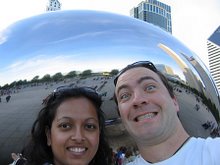


No comments:
Post a Comment